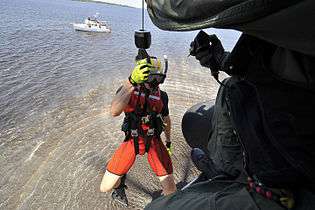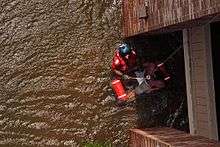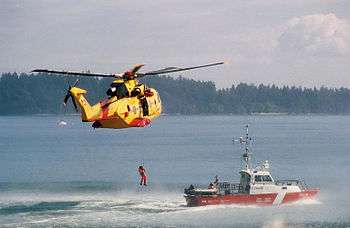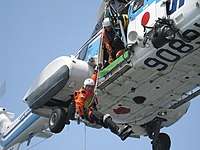Rescue swimmer
Rescue swimmer is a designation given to rescue specialists, most commonly in the service of the military. Rescue swimmers usually are charged with the rescue, assessment, and rendering of medical aid to persons in distress in the sea, on the land, or in the air. This highly specialized position is extremely challenging.

United States of America
U.S. Coast Guard

Arguably the most widely recognized team of rescue-swimmer operators, the elite United States Coast Guard Aviation Survival Technician (AST)/Helicopter Rescue Swimmer team is called upon to respond in the most extreme rescue situations. High seas, medical evacuations, downed aviators, sinking vessels, and hurricanes are some of the deadly scenarios that Coast Guard rescue swimmers are trained to handle. The Coast Guard's team of ASTs is composed of about 350 active-duty members, and just over 1000 members have passed the training to become Helicopter Rescue Swimmers since the mid-1980s. The training school has some of the highest attrition rate of any military school with about 80% of candidates washing out. For comparison, the attrition rate for United States Navy SEAL selection and training is about 75%[1]
AST School in Elizabeth City, North Carolina lasts for 24 weeks, and includes intense physical fitness, long hours of pool fitness and instruction, extreme water-confidence drills, and classroom instruction. The Coast Guard rescue swimmer training program is very challenging and is one of the toughest U.S. military training courses. Reportedly, only 75–100 Coast Guard personnel attend the school each year. The attrition rate in some years has been as high as 85%, although the 10-year average is just over 73%.[2] Prospective U.S. Coast Guard rescue swimmers are physically conditioned to meet high physical fitness standards. About half of prospective candidates make it to AST "A" School. Upon graduation, candidates must attend seven weeks of training at the Coast Guard's Emergency Medical Technician (EMT) school in Petaluma, California, where ASTs become EMT qualified. Rescue swimmers at Coast Guard Air Station Sitka, Alaska, must maintain the EMT-Intermediate level of proficiency due to the remoteness of their operational area and the number of medical evacuations performed by that unit each year. Once stationed at a Coast Guard Air Station, apprentice ASTs must complete 6 months of qualification on their respective airframe before moving on to finish their rescue swimmer syllabus and becoming journeymen.
The Coast Guard holds a one-week Advanced Helicopter Rescue School (AHRS, formerly known as Advanced Rescue Swimmer School) at Coast Guard Station Cape Disappointment, Washington, which is host to Air Force pararescuemen (PJs), Navy rescue swimmers, and foreign rescue departments as well. There, students learn the challenges of vertical-surface rescue, cliff operations, sea-cave traversing, and extreme-high-seas rescue. AHRS is considered the premier helicopter-rescue training school of its kind by most military and civilian rescue operators. [3]
The Coast Guard also trains a basic form of life-saving swimmers known as Cutter Surface Swimmers. These swimmers deploy only from ships and boats, and are tethered to a line handler stationed on board the vessel.
U.S. Air Force
United States Air Force rescue swimmers are called pararescuemen (PJs) and perform sea-based and land-based rescues, although the rescue swimmer portion of their duties is sparsely used.
Pararescue is a notoriously rigorous CSAR (combat search and rescue) unit, with eight out of every ten candidates failing the indoctrination course. This gives PJs one of the highest attrition rates of any of America's Special Operations Forces. PJs are an elite special operations component, engaging in combat search and rescue. They are trained as combatants and paramedics, operating on air, sea, and land, and are considered, along with Air Force combat controllers, among the most elite of the U.S. military's Special Operations forces.
During war, they rescue downed pilots, special-operations troops left behind, and other stranded military men and women. Pararescuemen are also active in peacetime, retrieving NASA space equipment, and also performing rescues in all types of natural disasters, though they get much less recognition for this role due to the small numbers of people rescued. The PJs are often sought out for use by other branches of the military because of their high-quality training and versatility. For example, Air Force pararescuemen can be attached to elite units to provide their expertise for various operations.
U.S. Navy/Marine Corps
United States Navy and Marine Corps rescue swimmer candidates attend a four-week Aircrew School followed by the five-week-long Aviation Rescue Swimmer School in Pensacola, Florida. After graduating rescue swimmer school, students go on to their respective 'A' School, also in Pensacola, Florida. Navy air rescue swimmers were recently split into two separate ratings. Which rating a rescue swimmer attains depends on what type of helicopter they are to become qualified in.
Once Navy rescue swimmers have graduated 'A' School, they will go on to their respective Fleet Replacement Squadron (FRS). Here crewman learn the various systems in the helicopter in which they will be flying. They are also expected to know various in-flight procedures, such as hoist-operating procedures and in-flight trouble-shooting. This syllabus can take from six to twelve months.
The last stop for a Navy rescue swimmer is SERE School (Survival, Evasion, Resistance, and Escape). Upon graduation from the brutal two-week course, they will go to the fleet as operational rescue swimmers. They will only be considered qualified Aircrewmen once they complete an additional 18-month PQS in their new squadron. Once they are qualified, they are eligible to wear Naval Aircrew wings.
Navy Surface Rescue Swimmers attend the four-week Surface Rescue Swimmer School in Jacksonville, Florida. 160th SOAR(A) has had personnel complete the course.
_conduct_Rigid_Hull_Inflatable_Boat_(RHIB)_Training.jpg)
Female rescue swimmers
Women must meet the same physical, endurance, and performance standards as men in order to earn a qualification as a Coast Guard rescue swimmer.
The first female US Navy rescue swimmer was Catherine Elliott (Rizzo), HMC (AC) USN Ret. She was also the first woman to graduate from Helicopter Anti-submarine Squadron in Jacksonville, Florida, and become a rescue swimmer on December 16, 1983.
The first female Coast Guard rescue swimmer was Kelly Mogk Larson, who joined the Coast Guard in 1984 and later became the first woman to complete Navy Rescue Swimmer School, on May 23, 1986.[4][5][6] On May 2013, Karen Voorhees was the first woman to be advanced to chief petty officer in the rating of aviation survival technician since women were integrated into Coast Guard active duty service in 1973.[7]
Canada

Royal Canadian Air Force Search and Rescue Technicians (SAR TECHs) serve as rescue swimmers. They are military aircrew who deploy from rotary or fixed-wing aircraft in any environment or climactic condition. They will locate and penetrate the site, then treat and evacuate casualties.
Qualified SAR TECHs have opportunities for advanced training and promotion. SAR TECHs who demonstrate the required knowledge, experience, and leadership skills may also be selected as an instructor at the Canadian Forces School of Search and Rescue (CFSSAR), at 19 Wing Comox, British Columbia.
The Basic SAR TECH course is 11 months in duration. It includes the following phases: ground phase, medical phase, winter operations phase, arctic operations phase, dive phase, sea operations phase, parachuting operations phase, mountain operations phase, and operational/consolidation phase. The final operational phase is used to evaluate the individual's ability to use all previously learned skills and will be the deciding factor in awarding the qualification to Wings Standard.
Denmark
Most rescue swimmers in Denmark are Danish Air Force personnel from the Danish Transport and Rescue Squadron (Squadron 722 or in Danish Eskadrille 722), and operate from AgustaWestland EH101 helicopters. These rescue swimmers have to be fully qualified as helicopter technicians before they start a 4-week course at the Danish Frogman Corps, followed by a 2-week first aid/PHTLS course.
Other rescue swimmers are members of the Danish Navy and operate from Westland Lynx Mk 90B helicopters based on Thetis-class ocean patrol vessels in the waters around Greenland, the Faroe Islands, and, occasionally, Iceland. These swimmers are generally recruited from the diver-corps (which has a 6-to-10-week diving course from the Danish Navy Diving School) and receive basic helicopter-crash-survival training.
Some coast-based rescue swimmers with high-speed boats are stationed around the coasts of Denmark. These rescue swimmers are trained by either the Danish national guard or Danish Maritime Safety Administration (Danish: Farvandsvæsnet).
Japan

In Japan, air-sea rescue operations are mainly conducted by the Japan Coast Guard (JCG), the Japan Maritime Self-Defense Force (JMSDF) and the Japan Air Self-Defense Force (JASDF).
In the JCG, divers (潜水士, Sensui-shi) have been conducting public safety diving. And now there are two additional categories of rescue-swimming specialists: mobile rescue technicians (機動救難士, Kidō-kyūnan-shi) and the top-tier Special Rescue Team (SRT). They are divers specially trained to acquire some advanced techniques including abseiling, and some are also qualified as emergency medical technicians to provide medical treatments.[8]
In the JMSDF, helicopter rescue swimmers (HRS) are selected from assistant nurses and trained as both aircrew and divers.[9] In contrast, paramedics (救難員, kyūnan-in) of the JASDF, Japanese counterparts of the United States Air Force Pararescue, are not always medical professionals, but they must complete the Airborne Ranger Course of the Japan Ground Self-Defense Force to acquire mountain rescue and combat search and rescue capabilities.[10]
Rescue swimmers in the media
The release of the 2006 motion picture The Guardian, starring Kevin Costner and Ashton Kutcher, introduced viewers to this small group of elite rescue workers.
A rescue swimmer saves Tom Cruise's character Maverick in Top Gun. The rescue swimmer's name is John Baker, the name of a former Navy SAR School Instructor at NAS North Island in the early 1980s.
On the History Channel reality show Top Shot, one of the marksmen is US Navy rescue swimmer Jamie Franks.
U.S. Coast Guard rescue swimmers attracted international attention during the rescue operations following Hurricane Katrina in New Orleans, Louisiana, and surrounding areas. It was reported that in the first five days following Katrina, Coast Guard crews performed more than 33,500 rescue and hoist operations of Katrina victims stranded on rooftops and in flood water. This was reportedly more than the Coast Guard had rescued worldwide in over 50 years. President George W. Bush awarded the active, reserve, auxiliary and civilian employees of the Coast Guard a Presidential Unit Citation and ribbon for their response to Hurricane Katrina.[11]
While Katrina brought domestic and international news coverage to Coast Guard rescue swimmers and their crews, their story was first shown on television in a series of 1999 specials on Discovery Channel, Coast Guard: Rescue Swimmers and Coast Guard: Helicopters to the Rescue. Along with covering the history and the demanding training rescue swimmers must complete, the specials also feature dramatic on-scene footage of several heroic rescues.
The most-viewed rescue swimming event in the media was a marine rescue done by rescue swimmers during the Webtel.mobi Intercontinental Challenge on November 25, 2009. The Webtel.mobi Intercontinental Challenge was the first attempted intercontinental flight between Africa and Europe by man using jetwings, and it was broadcast live worldwide on television. Swiss pilot Yves Rossy, the person who had accepted the Webtel.mobi Intercontinental Challenge, had to ditch into the North Atlantic Ocean midway through the 30-mile flight from Morocco to Spain after his wing was destabilized by a large cumulonimbus cloud. After being located, an emergency marine rescue was undertaken by rescue swimmers live on television, with the Associated Press reporting that more than two billion people had viewed the rescue worldwide on the day of broadcast. The rescue swimmers for this emergency were Stuart Sterzel and Garth Eloff, both former special operators from Special Forces. Stuart Sterzel was also the CEO of Webtel.mobi, the company staging the event. A third standby rescue swimmer was John Brokaar, also a former special operator from Special Forces. The rescue took place in extremely dangerous conditions in the North Atlantic, with the downed pilot being located in less than 15 minutes after his ditched entry into the ocean, in an area where the average time for locating a person in the water is four hours. Once located, he was extracted from the water in a flawless marine rescue. The success of the rescue was credited to the rescue rehearsal carried out on the day before the event, which was also televised worldwide as it happened. The rehearsal took place during a rough-sea state and high winds, and was done to confirm that the rescue swimmers would be able to carry out an effective rescue in the dangerous conditions in the area, which include very strong rip currents, high swells, and cold water temperature in the North Atlantic. On the day of the rehearsal, the rough-sea state and high winds forced Sterzel and Eloff to exit into the North Atlantic Ocean from the skid of a Bell helicopter at a height of over 40 feet, which causes significant water-entry shock on entry. The water-entry shock was reduced only by their succeeding in entering the water at an optimal entry angle despite the high wind and an unstable exit platform. This was attributed to their previous training and experience.
See also
- Aircrew (Flight crew)
References
- The entire list of graduates can be found here.
- Official web page, National Motor Lifeboat School, US Coast Guard official website.
- Pioneers in Aviation by Martha LaGuardia-Kotite
- U.S. Coast Guard History Program
- First female Coast Guard rescue swimmer retires.
- LT Stephanie Young, First female rescue swimmer promoted to chief petty officer. Coast Guard Compass - Official blog of U.S. Coast Guard, Tuesday, May 28, 2013.
- Awadu Hideya (December 4, 2015). 海上保安庁の救急救助体制について [Marine Rescue Systems of the Japan Coast Guard] (PDF) (Report).
- 22nd Air Wing. 機上救護員紹介 [An Introduction to MEDIC]. Retrieved July 13, 2020.
- North Kanto Defense Bureau (September 2014). 特集!航空自衛隊新潟救難隊 [Feature on the Niigata Rescue Squadron of the Air Self-Defense Force]. North Kanto Defense Bureau PR brochure.
- U.S. Coast Guard Presidential Unit Citation https://www.uscg.mil/Portals/0/OurOrganization/auxiliary/awards/PUC_citation0506.pdf?ver=2017-10-01-082256-360
Bibliography
- Martha J. Laguardia-Kotite, Tom Ridge. So Others May Live: Coast Guard Rescue Swimmers Saving Lives, Defying Death. The Lyons Press, 2006, ISBN 978-1-59921-159-6
- Shawn Lansing. The Marine Electric tragedy: So others may live. Coast Guard Compass - Official blog of U.S. Coast Guard, Monday, February 13, 2012.
.jpg)